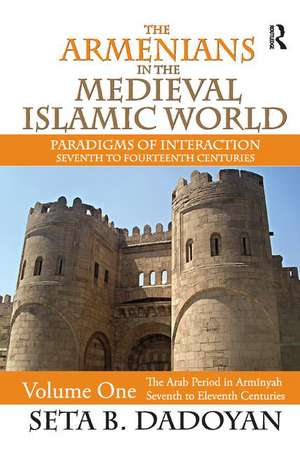The Armenians in the Medieval Islamic World: The Arab Period in Armnyahseventh to Eleventh Centuries
Editat de Seta B. Dadoyanen Limba Engleză Paperback – 28 sep 2017
Contradictory trends went into the making of Armenian history, yet most narratives fail to reflect this rich texture. Linking Armenian-Islamic history is one way of dealing with the problem. Dadoyan's concern is also to outline revolutionary elements in the making of Armenian ideologies and politics. This extensive work captures the multidimensional nature of the Armenian experience in the medieval Islamic world.
The author holds that every piece of literature, including historical writing, is an artifact. It is a composition of many elements arranged in certain forms: order, sequence, proportion, detail, intensity, etc. The author has composed and arranged the larger subjects and their sub-themes in such a way as to create an open, dynamic continuity to Armenian history that is intellectually intriguing, aesthetically appealing, and close to lived experiences.
| Toate formatele și edițiile | Preț | Express |
|---|---|---|
| Paperback (3) | 324.16 lei 43-57 zile | |
| Taylor & Francis – 28 sep 2017 | 324.16 lei 43-57 zile | |
| Taylor & Francis – 28 sep 2017 | 325.34 lei 43-57 zile | |
| Taylor & Francis – 28 sep 2017 | 325.34 lei 43-57 zile |
Preț: 324.16 lei
Preț vechi: 432.00 lei
-25% Nou
Puncte Express: 486
Preț estimativ în valută:
62.05€ • 67.42$ • 52.15£
62.05€ • 67.42$ • 52.15£
Carte tipărită la comandă
Livrare economică 21 aprilie-05 mai
Preluare comenzi: 021 569.72.76
Specificații
ISBN-13: 9781138515390
ISBN-10: 1138515396
Pagini: 235
Dimensiuni: 152 x 229 x 26 mm
Greutate: 0.45 kg
Ediția:1
Editura: Taylor & Francis
Colecția Routledge
Locul publicării:Oxford, United Kingdom
ISBN-10: 1138515396
Pagini: 235
Dimensiuni: 152 x 229 x 26 mm
Greutate: 0.45 kg
Ediția:1
Editura: Taylor & Francis
Colecția Routledge
Locul publicării:Oxford, United Kingdom
Cuprins
Contents of Forthcoming Volumes in This Series Transliteration Tables Prologue Introduction I. Armenian Historiography and the Book as an Argument II. Introduction to Volume One 1. Factors in the Pre-Islamic Armenian Condition— Fourth–Seventh Centuries I. East–West Rivalries: Kings, Catholicoi, Naxarars, Common People II. The Cultural Policies and the Legacy of Fundamental Loyalties of the Classical Age III. Defi nitions of Armenian Orthodoxy and the Synthesis of Eznik (mid-Fifth Century) A. The Book of Dissidents or Refutation of Sects (Ec Aandoc') B. The Fundamentals of Eznik's Synthesis IV. Early Armenian Social–Religious Dissent A. The Eustathian Heretics of Sivs—Canons of the Council of Gangra (c.374) B. The Councils of sahapiwan (447/8) and Dwin (554/5)—Messalians, Nestorians, Paulicians 2. Early Arab Campaigns and the Regulation of Relations According to the Mednan Legacy I. Medieval Armnyah between Byzantium and the Islamic World—The Early Period II. A Brief Survey of Sources—Arab and Armenian III. Early Arab Campaigns: Armnyah between Arabs and Byzantines IV. Regulation of Islamic–Armenian Relations A. The Treaty of Mu'wiyah (652) B. The Treaty of Habb Ibn Maslamah (654) V. The Mednan Legacy as Paradigm for Islamic–Armenian Treatises A. The 652 Treaty as a Link in the Tradition of Mednan Oath B. The Alleged Prophet's Oath to the Armenians, and the Jerusalem Connection 3. The Umayyad Period and the Reconfirmation of Oaths I. The Early Decades II. Change of Status in 692–693/73H III. Muhammad Ibn Marwn, the Rebellion of 703 and the Reconfi rmation—Th e Little Man sr IV. Continuation of the Legacy: Th e Covenant of Caliph'Umar II to Catholicos jnec'i V. The Later Umayyad Period in Armenia: Dissidence and Heterodoxy as Paradigms of Interaction 4 The Armenians in the'Abbsid World—Th e Paradigms of Borderlands and Dissidence I. The'Abbsids and the Persian–Islamic Legacies II. The'Abbsid Project of Borderlands III. Armenia under the'Abbsids to the Year 862/248H IV. The Arab Tribal Emirates in Armenia V. Dissident Versus Orthodox Politics—Paulicians, Babakians, and T'ondrakians A. Social Unrest in Apahunik' and Siwnik' in the Ninth–Tenth Centuries B. Paulicians, T'ondrakians, and Babakians— Paradigm of Near Eastern Dissidence VI. Paradigms of Syncretism and the Borderlands: The Paulician–Muslim Alliance—Digenis Akritis as History A. The Paulicians and the Muslim Alliance B. Digenis Akritis: Epic and History C. Digenis Akritis: Summary and Highlights of the Grottoferrata and Escorial Versions 5 Armenian Dynastic Principalities or the Age of Kingdoms I. The Bagratunis and Arcrunis II. The Tenth Century: Prosperity and Turmoil III. The Hamdnids in Armenia and North Shm IV. The Crusade of Tzimiskes and Armenian Settlements V. Basil II the Bulgar-Slayer (976–1025) and the Armenians—Th e Watershed VI. The Last Armenian Kingdoms VII. Reformist-T'ondrakian Episodes—1000–1054/5 Summary: The Arguments in Volume One Bibliography Appendix Index
Descriere
In this first of a massive three-volume work, Seta B
